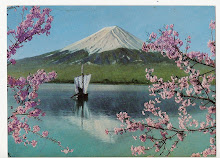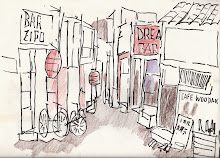I have a title for this photo: One Mastepiece by Owen Finn. I could write a novel about such scenes, really.
YOKOHAMA PICTURE SHOW

Shot with my Petri in Yokohama 1962
RICE FIELD IN JAPAN 1962

I took this with my PETRI in Kanagawa Prefecture
Sunday, August 14, 2011
Best Place to Write Novels
Yes. Once I get back to Japan, I hope to find a room like this to write the novel that lives in both my heart and mind.
Thanks to Yoshihiko Inui for a photographic masterpiece.
maiko od genka
...she sent me a photograph of herself in a kimono like this one and I was sorry that we had said "sayonara." That was in 1964.
THE BEACH VENDOR -- A Happy Snack of Japanese "Oden"
THE BEACH VENDOR -- A Happy Snack of Japanese "Oden"
Ca.1898 photograph by T. ENAMI of Yokohama. ODEN....Yummy ! What you are looking at here is the Japanese equivalent of a Hot Dog Stand along the boardwalk of Atlantic City or Coney Island. If native Japanese looked at this picture while hungry, they would probably start to drool. www.t-enami.org/
MOTOMACHI STREET SCENE 1962, By Robert L.Huffstutter
HISTORY OF MOTOMACHI, WIKIPEDIA REFEERNCES.......
Motomachi was originally a quiet farming and fishing village until 1859, when the Port of Yokohama was opened. Since then, the close-by Kannai district became the foreigners' business district, and the adjacent Yamate and Yamashitacho districts became the foreigners' residential districts. Situated in-between, with Yamate to the east, and Kannai and Yamashitacho to the west, Motomachi became frequented by many foreigners. Shops and businesses were opened, catering to the needs of foreigners.
Soon after the start of the Meiji era, the number of foreign residents increased. And western influence became more evident in Motomachi, with the opening of many cafés, bakeries, and boutiques. Such shops were uncommon in Japan at the time, and Motomachi helped introduce Western culture into Japan, as part of what is called bunmei kaika (文明開化?). This was the beginning of the Motomachi Shopping Street as it is known as of 2008.
In the 1970s, the "Motomachi Shopping Street" produced a new style of fashion called the hama tora (ハマトラ?) (short for "Yokohama traditional"). The most famous producers of the hama tora style were Kitamura [1], Mihama [2], and Fukuzō [3], three of the most fashionable boutiques in Motomachi.
In the 1960s, on one end of Motomachi stood the German Bakery and next door was the fantastic Madame Pompadour Bakery with the best puff pastry imaginable. When the aromas filled the street on Saturday mornings it was beyond description. On the end stood (and stands today) Nakayas grocery store, which sold wonderful liquor spiked communist jellies and jams from Czechoslovakia; nearby the vinyl record store which made available many popular 45 rpm records of the day on RCA Victor such as the Monkees and the Beatles. In between as today stands the Union Supermarket where one could purchase US or Japanese versions of the same cereals such as Sugar Pops. And across the street stood the French Restaurant with the best chocolate ice cream.
[edit] NamingUpon the opening of the Port of Yokohama in 1859, this area was called Motomura (本村?). The name was changed to Motomachi in 1860.
en.wikipedia.org/wiki/Motomachi,_Yokohama











